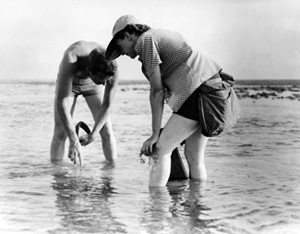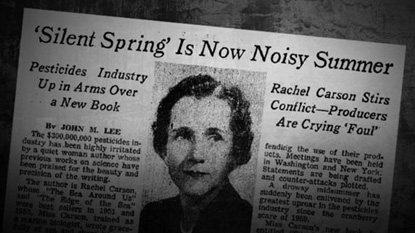Rachel Carson, with her scientific expertise, compelling writing, and unflagging courage, sparked the nation and took it in a new direction in terms of fighting pollution and protecting the environment.
Born in 1907, Carson grew up in rural Pennsylvania and, as a young girl with a love of the outdoors, wanted to be a writer and make nature’s creatures “as alive to others as they are to me.” After majoring in biology and earning a masters in zoology from Johns Hopkins University, and facing professional roadblocks against women in the sciences, she took a position as a science writer at the U.S. Bureau of Fisheries, where she wrote many articles and soon was elevated to editor-in-chief of publications.

Carson wrote three early and extraordinary books, Under the Sea-Wind (1941), The Sea Around Us (1952), and, after leaving the Bureau of Fisheries to pursue fulltime writing, The Edge of the Sea (1955). The last two became bestsellers and The Sea Around Us won the National Book award. One observer called these works, at once scientifically precise and beautifully written, a “biography “ of the Atlantic Ocean.
By 1958, Carson, now a well-known and highly regarded scientist, was working on a new and far-reaching project. For years, she had wondered about the connection between pesticides, especially DDT, and cancer, and spent increasing amounts of time researching the subject. Now the evidence of the impacts on human health and lives had mounted, and she felt she had no choice but to go public with it, writing that “It was pleasant to believe that much of Nature was forever beyond the tampering reach of man: I have now opened my eyes and my mind. I may not like what I see, but it does no good to ignore it."
These would be difficult years for her. Carson’s niece had died and she became legal guardian of her grandnephew, age 5. Carson, who lived alone, also had to care for and support her aging and ailing mother. Carson’s own health took a turn for the worse. Breast cancer was diagnosed and required radiation.
Then the magnitude of the DDT project, coupled with the anger and aggressiveness of industry, intensified the pressure on the modest, soft-spoken Carson. The chemical companies had learned of her work and leapt into action, unleashing an all-out attack in an effort to prevent the publisher, Houghton Mifflin, from releasing the book. As Time magazine reported:
“Carson was violently assailed by threats of lawsuits and derision, including suggestions that this meticulous scientist was a "hysterical woman" unqualified to write such a book. A huge counterattack was organized and led by Monsanto, Velsicol, American Cyanamid—indeed, the whole chemical industry—duly supported by the Agriculture Department as well as the more cautious in the media.”

Yet neither the author nor her publisher relented. Carson’s epic, Silent Spring, after being serialized in The New Yorker, was published in 1962. The book ‘s conclusions were too accurate, too careful—too powerful—for the chemical companies to overcome. Carson documented the effects of DDT and other chemicals clinically and in detail. Her writing was also often lyrical. In addition to detailing the impacts on humans, she imagined a future silent spring:
“There is a strange stillness. The birds, for example, where had they gone? ... It was a spring without voices. On the mornings that had once throbbed with the dawn chorus of robins, catbirds, doves, jays, wrens, and scores of other bird voices there was now no sound; only silence lay over the fields and woods and marsh.”
Silent Spring, widely read, resonated with scientists, political leaders, public officials, and the American people generally. It spoke both to specific issues of DDT and, broadly, to the callous disregard that humans too often showed toward the natural world. President Kennedy endorsed the book at a press conference and appointed an investigative committee, which in time issued an influential report; Earth Day was born in 1970; the use of DDT was banned in the United States in 1972; the Clean Water Act, Clean Air Act, and numerous other pollution laws were enacted in the 1970s; Silent Spring was acclaimed as one of the most important books of the 20th century and Time magazine listed Carson as one of the 100 most influential people in the 20th century. Rachel Carson lived to testify on her findings in front of Congress but died of cancer in 1964 at the age of 56.
The publication of Silent Spring in 1962 is as good a place as any to mark the beginning of the modern environmental consciousness and movement.
America’s Top 10 Conservation Heroes is a series honoring the individuals and organizations that have made the biggest mark on conservation, environmental protection, and awareness of the outdoors. The series is written by Charles Wilkinson, Distinguished Professor at the University of Colorado and author of fourteen books on law, history, and society in the American West.
Header Photo: Rachel Carson testifying before Congress in 1964 (Credit: AP)
America’s Top 10 Conservation Heroes
1. Theodore Roosevelt
2. John Muir
3. Rachel Carson
4. Stewart Udall
5. Aldo Leopold
6. Ansel Adams
7. Earthjustice
8. Henry David Thoreau
9. Edward Abbey
10. Bruce Babbitt
